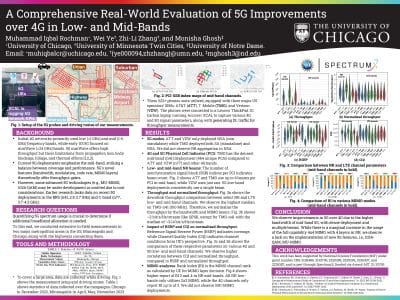Authors
Muhammad Iqbal Rochman, Wei Ye, Zhi-Li Zhang, and Monisha Ghosh
Abstract
As discussions around 6G begin, it is important to carefully quantify the spectral efficiency gains actually realized by deployed 5G networks as compared to 4G through various enhancements such as higher modulation, beamforming, and MIMO. This will inform the design of future cellular systems, especially in the mid-bands, which provide a good balance between bandwidth and propagation. Similar to 4G, 5G also utilizes low-band (<1 GHz) and mid-band spectrum (1 to 6 GHz), and hence comparing the performance of 4G and 5G in these bands will provide insights into how further performance improvements can be attained. Hence, we conduct city-wide measurements of 4G and 5G cellular networks deployed in low- and mid-bands in Chicago and Minneapolis, and carefully analyze the performance to quantify the contributions of different aspects of 5G advancements to its improved throughput performance. Our analyses show that (i) compared to 4G, the throughput improvement in 5G today is mainly influenced by the wider channel bandwidth, both from single channels and channel aggregation, (ii) in addition to wider channels, improved 5G throughput requires better signal conditions, which can be delivered by denser deployment and/or use of beamforming in mid-bands, (iii) the channel rank in real-world environments rarely supports the full 4 layers of 4×4 MIMO and (iv) advanced features such as MU-MIMO and higher order modulation such as 1024-QAM have yet to be widely deployed. These observations and conclusions lead one to consider designing the next generation of cellular systems to have wider channels, perhaps with improved channel aggregation, a deployment architecture that is dense and uses more beams, thus ensuring uniformly better signal strength over the coverage area and no more than 4 MIMO layers per user.

